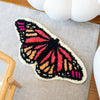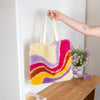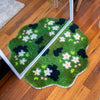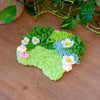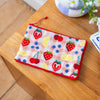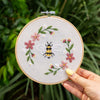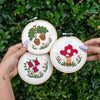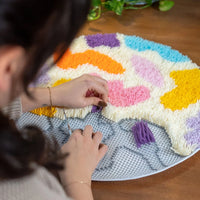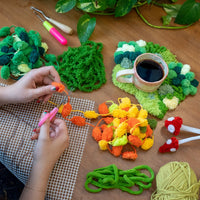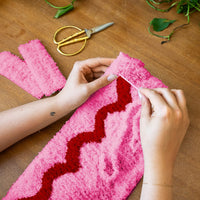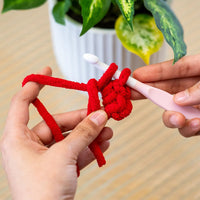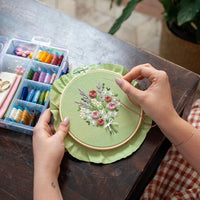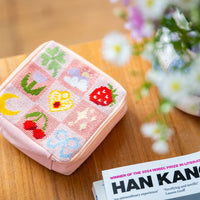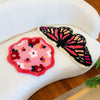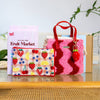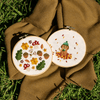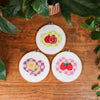Step by Step Guides
Flower Field Embroidered Tote
Welcome to our step by step guide for your Flower Field embroidered tote kit! I'm so grateful that you've chosen to try embroidery with one of our kits.
This step-by-step guide can be used in addition to or instead of your paper instructions. The benefit of this guide is that each stitch tutorial is listed below, making it even easier to complete your piece without stress!
If you find yourself having any trouble with stitches, reach out to me at hello@craftclubco.com to book a one-on-one 'help me!' session.
Without further ado, LETS GET STITCHING!
Prepping Your Hoop & Thread
Before beginning your kit, you'll be setting up your hoop and threading your needle.
Setting Up Your Hoop
- To use your hoop, separate the inner and outer hoop by loosening the metal screw at the top.
- Place your inner hoop (the one without the metal piece) inside your tote, roughly centering around the area you'd like to work on.
- Place the outer hoop on top of the inner hoop, over your tote bag. Make sure you're doing this on a flat hard surface as it ill make it much easier to push the outer hoop down.
- Use the screw to tighten the hoop until the fabric as much as you can. With regular embroidery you'll want your fabric taut like a drum, but for your canvas tote you'll just want it as tight as is comfortable. The cotton canvas has more structure than linen, meaning that your hoop can be a little bit looser and not cause the stitches to wrinkle.
- Adjusting the hoop can take a bit of time. Start by screwing it a little tighter, then adjust the fabric, then screw again. You want the hoop to feel secure on your tote, so that it won't move about or fall off.
- You may need to move your hoop around as you stitch your design - this is totally normal! You can put your hoop over previously stitched areas, so don't be afraid to move your hoop as needed.
- Canvas can even be stitched without an embroidery hoop! If you're really not liking how it feels to use a hoop - give that a try too. You might prefer it!
Threading Your Needle
- Your thread comes as six individual strands combined to make one string. When stitching we will often split the string and used the desired number of strands for the stitch.
- Cut approximately 60cm (or roughly an arms length) of thread then separate the number of strands you'll need for the following stitch.
- This tote uses 6 strands of thread for each of your designs, meaning you won't need to split your thread for this project. But it's still handy to know for any future embroidery projects you might do!

- Use one of your pink needle threaders to thread your needle, pulling the thread partially through the needle. Don't pull the thread all the way through to the middle, just enough so it feels secure and your needle won't slide away.
- Then tie a knot at the end of your thread. You can do a double knot if you like, but just a single knot is usually enough for the type of linen included in your kit.

Beginning Your Flower Field Tote
For this piece you'll be using 7x beautiful stitches.
What's handy about this tote is that you'll learn a few different ways to stitch your stems, leaves and flowers. If you ever find yourself not enjoying a particular stitch, simply swap it out for another stitch you prefer. It's all about enjoying the journey!
Stitches Included:
- Back Stitch
- Straight Stitch
- Lazy Daisy Stitch
- French Knots
- Split Stitch
- Whipped Back Stitch (aka. Whip Stitch)
- Long & Short Stitch
Step 1 - Blue Flowers
You'll begin your tote bag by stitching the top blue flower. Start with the stems and leaves using #989 (light green) thread. Use a BACK STITCH for the stem and small STRAIGHT STITCHES for the little leaves.
Next work on the petals using #827 (blue) thread. Each flower is made up of 3x LAZY DAISY stitches, with each lazy daisy meeting at the same point at the top of the stem.
Now move on to your bottom blue flower. Starting in the same way, you'll use a BACK STITCH to create the stems, this time using #986 (dark green) therad. For the leaves use a LAZY DAISY stitch.
Using #827 (blue) thread, you will make your petals using LAZY DAISY stitch, this time facing the opposite way to your first flower. Finish off the flowers with a single FRENCH KNOT using #3822 (yellow). If you like, you can leave all your french knots til the very end of your piece since they can be a little tricky.
Straight Stitch Video Tutorial - American Quilting
Back Stitch Video Tutorial - by Mary Corbet
Lazy Daisy Video Tutorial - By Cutesy Crafts
French Knot Video Tutorial - by River Birch Threads
Step 2 - Orange Flowers
Now onto your left orange flower. Start by stitching the stem with a SPLIT STITCH, using #989 (light green) thread. Create the leaves using LAZY DAISY stitches.
For your petals stitch LAZY DAISIES using #3853 (orange) and finish off your flower with a FRENCH KNOT in the centre with #3822 (yellow). It can be tricky to pull your needle through your french knot when it's in the middle of a lazy daisy, so you may need to pull quite firmly to get it through.
Your right side flower uses the same techniques, starting with a SPLIT STITCH in #986 (dark green) thread, followed by LAZY DAISY leaves. Complete the flower using LAZY DAISIES and a FRENCH KNOT in #3853 (orange) and #3822 (yellow).
Split Stitch - Penguin & Fish
See step 1 for Lazy Daisy & French Knot tutorials.
Step 3 - Purple Flowers
Your next flower will be the top purple one. Begin by stitching the stems using a WHIP STITCH in #986 (dark green) thread. Then use LONG & SHORT STITCH to fill in the curved leaf shapes. Use shorter stitches for curved shapes so that the lines are smooth.
The two flowers are made using LAZY DAISY stitches in #209 (purple) thread. Finish them off with #3853 (orange) FRENCH KNOTS.
Your bottom purple flower uses the same techniques, starting with a WHIP STITCH in #989 (light green) thread. Stitch the curved leaf using LONG & SHORT STITCH. Again you will use LAZY DAISIES for the petals of your flower, but this time each petal will go either side of the stem.
Whip Stitch (aka Whipped Back Stitch) Video Tutorial - by Cutesy Craft
Long & Short Stitch - by Love Crafts
See step 1 for Lazy Daisy & French Knot tutorials.
Step 4 - Pink Flower
You're on to your last flower! YAY.
The pink flower in the middle of your tote bag starts with SPLIT STITCH in #989 (light green) for the stem. Use LAZY DAISIES to fill in the leaves. Using #356 (dark pink) fill in your flowers using LAZY DAISY stitch.
Finish off your flowers with your #3822 (yellow) FRENCH KNOTS.
See step 1 for Lazy Daisy & French Knot tutorials.
See step 2 for Split Stitch tutorial.
Step 5 - Background Flowers
The very last step is to fill in the background flowers. Fill the pink flowers using #225 (light pink) and LAZY DAISY stitch. The yellow flowers use #3822 (yellow) and STRAIGHT STITCH. Simply create 3x straight stitches, overlapping them to make a tiny starburst.
See step 1 for Lazy Daisy & Straight Stitch tutorials.
You've Finished Your Masterpiece!
Washing Your Piece
If there are blue lines from the pattern still visible when you've finished your piece, it's time to give it a rinse. If you can't see any blue lines (or they're small enough not to be noticeable) then you can skip this step!
To wash your lines off, take your hoop off your tote and rinse under warm water. You can gently rub the ink with your fingers to remove it. If the ink is being stubborn you can even rinse your fabric with a mild soap.
Once it's clean, leave your tote to dry on a flat on a hand towel away from direct sunlight. You can also press another hand towel gently on top of it to soak up excess water.
Ironing Your Tote
If your tote is very wrinkled, you may want to iron it. Generally, you won't need to do this unless it's very creased because once you start using your tote any wrinkles will go away.
Place your tote inside out on a towel on top of your ironing board. You want the back of your embroidery facing upwards. Next place a tea towel on top of your embroidered tote, to protect it from the direct heat of the iron.
Iron your tote on a medium setting, checking on it as you go. If the creases are stubborn you can increase the setting of your iron, as linen and cotton are okay with higher temperatures. I always suggest doing this gradually, rather than going in straight away with full heat, as the last thing you want to do is burn your piece!
Caring For Your Tote
As with any embroidered piece (even ones that are machine-made) you'll want to take care when using your tote, avoiding excessive wear so that your bag will last as long as possible.
Tips for extending the life of your bag:
- When using your bag, keep the stitched side facing out so that it's less likely to rub on your clothes and wear down.
- Be careful with and metal hardware from a handbag or jacket in case it gets caught on your embroidery. If this happens, don't worry! You'll have enough extra thread in your kit to restitch that flower.
- Don't use it for any wet, greasy or smelly groceries. You don't want your tote getting stained with a BBQ chook!
- Be careful where you put your tote bag. Don't put it on the bathroom floor if there is a mess or sit it on the ground if there could be mud. It's hard to remove dark stains from canvas.
If your tote bag needs a wash, simply follow the same steps listed above for removing the ink design. You can also use a stain remover on the blank areas of the tote, but be careful not to get this on your thread as it could impact the colours on your stitches.
Always let it air dry, as using a dryer could damage your stitches.
And you're done! Congratulations on finishing your Flower Field tote bag. I hope you had a fantastic experience stitching it and will get lots of use out of your me-made creation.
Nakisah x
Craft Club's Founder

